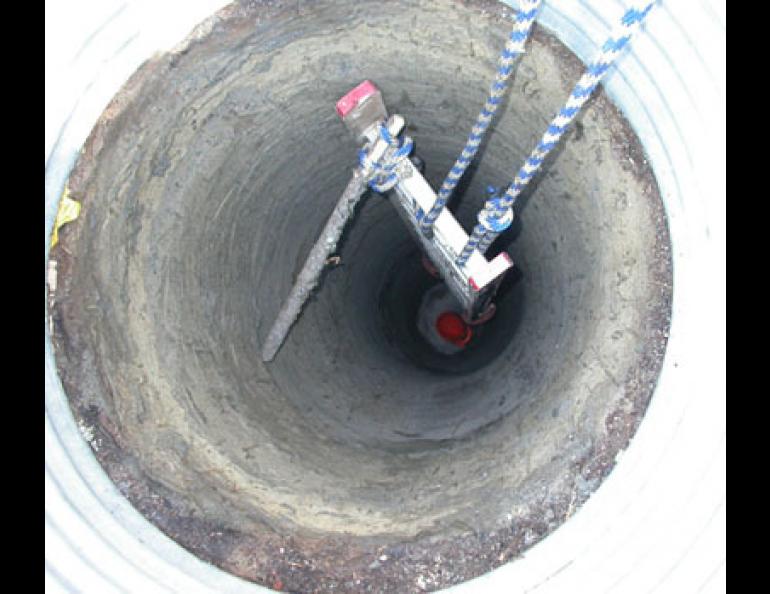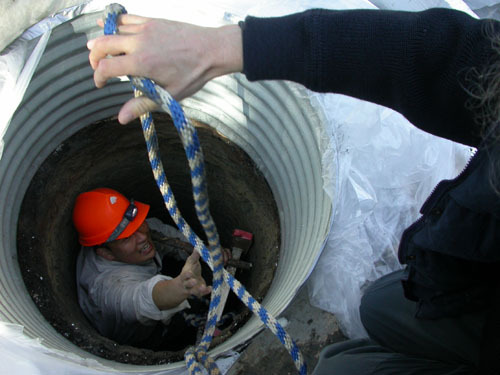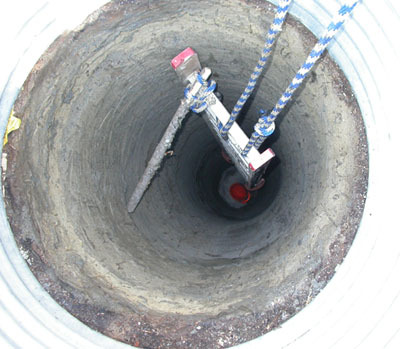

The view from inside a pingo
Hanno Meyer smiled like a little boy when he emerged from a 30-foot hole drilled into a forested mound in Interior Alaska.
“Even though I am studying permafrost, it’s the first time I’ve been in a pingo,” said Meyer, who had the day before flown to Fairbanks from Potsdam, Germany, where he works at the Alfred Wegener Institute for Polar and Marine Research.
The guide to Meyer’s tour inside an Alaska pingo was Kenji Yoshikawa, an assistant professor of water resources at the University of Alaska Fairbanks. While Meyer was en route, Yoshikawa had supervised the drilling of a 30-foot deep, two-foot wide hole into the solid ice west of Fairbanks.
Pingos are mounds with cores of ice that pimple the landscape of Arctic and Interior Alaska. The mounds can range from the size of a Volkswagen Bug to a domed stadium, and the one Yoshikawa drilled into is large enough to provide the foundation for a castle. But no castles sit atop Yoshikawa’s pingo; there are only spruce trees and a carpet of moss.
Pingos form in the Interior because of permafrost—soil that remains frozen for at least one year. Ice-rich permafrost in valley bottoms is a barrier to artesian groundwater (water under pressure that wants to flow upward), but springs sometimes bubble up through small fractures in the frozen ground, allowing water to escape toward the surface. If the climate is cold enough, the spring water will freeze in the permafrost before it reaches the surface, creating a buried core of massive ice that lifts tremendous amounts of soil as it expands. Thousands of years are required for pingos to grow to the size of the one Yoshikawa drilled.
“That’s methane,” Yoshikawa said. Methane is the gaseous remains of ancient plant and animal life. The gas is a major concern of researchers who study greenhouse gases and the warming of the north. Permafrost in the Arctic and subarctic holds an incredible amount of methane, ready to be let loose in the atmosphere if the permafrost melts.
Yoshikawa has big plans for the Fairbanks pingo. He wants to find the ages of the ice layers inside and use isotopic tests to determine where the water captured in the pingo came from. By looking at the chemistry of the ice, researchers can determine the original source of the precipitation that over centuries became a pingo. Knowing the origin of the water might tell Yoshikawa and other researchers how climate patterns have evolved in Interior Alaska. Some water may have originated in a weather system born over the Bering Sea, for example, or maybe the Gulf of Alaska or Mackenzie River delta. The pingo will also yield ancient plant and animal life. On drilling day, Yoshikawa found an ancient bone, perhaps part of a hip, preserved in the permafrost about seven feet below the ground surface.
This summer, Yoshikawa wants to dig a tunnel through the side of the pingo to meet the vertical drill hole. He has prior experience, having dug into a pingo in Svalbard, a Norway territory in the high Arctic, for his graduate work. In Fairbanks, he will use an electric jackhammer and chainsaw to tunnel through the clear ice of the pingo. Yoshikawa did not have those luxuries in Svalbard, where he spent an entire summer chipping into a pingo with picks and other hand tools.
“It was very fun,” Yoshikawa said.






